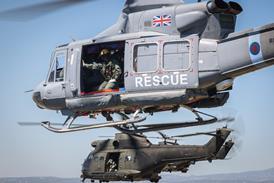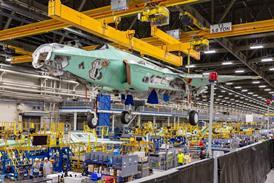Ian Sheppard/LONDON
Progress in the development of airbreathing powerplants for hypersonic vehicles has been hampered since the 1960s by unexpected complexities encountered with the scramjet (supersonic-combustion ramjet), until recently the only real candidate for powering such high-speed craft. In an effort to address the impasse, leading international figures in hypersonics gathered at the Towards Mach5: Hypersonic Flight conference in London on 3-4 November.
While NASA is actively investigating an alternative to the scramjet, computing power is increasing to a point where the complex aero-thermodynamic flows in the scramjet are beginning to be simulated far more effectively, and it is increasingly likely that the first real applications will be seen within the next decade.
Hypersonic speed is reached at around Mach 5.4, when some of the flow permanently stagnates on the vehicle's leading edge, and engine-inlet pressure becomes too great for ramjets, where the flow is slowed to subsonic speeds for combustion. In a scramjet, combustion takes place in supersonic flow, lowering pressure, but giving rise to new problems.
RAPID FIRE
The combustor is the most problematic part of the scramjet, and achieving net positive thrust remains the first hurdle to be overcome, says Bob Mercier, chief of the US Air Force's HyTech hypersonic-missile programme (Flight International, 12-19 November). "Technical challenges of the 1960s are still valid today," says Mercier, who would like to see a move towards "a standard combustor design for world use".
Mercier says that the challenge is to reduce the fuel ignition-delay time in the combustor to one tenth of the period of the fuel-inlet duct "natural resonance", to allow stable combustion in a short-enough length to keep drag and heat loss to a minimum. He cites Gencorp Aerojet's "Strutjet" proposal for HyTech, where injection from struts in the flow reduces combustor length, but increases skin-friction drag.
Environmentally unfriendly hydrogen-cyclane additives are traditionally used to promote combustion, but "-the need for this must be eliminated", says Mercier. "We are looking at endothermic fuels to get the one-tenth time criteria - it's the single main problem we're facing," he adds. In theory, these fuels decompose endothermically into hydrogen and a lower hydrocarbon in a reaction which absorbs heat energy, thus providing in-built cooling. The hydrogen is then available as a high calorific-value without needing to store it.
Bob Faulkner, deputy director of Pratt & Whitney's powerplant proposal for HyTech, says that it has developed a way to "-alter the reformed [endothermic] JP7 kerosene as it goes to the injector" in an "aerothermal demonstrator", but says "-system specifics are secret". He says that more tests are scheduled for this year, extending from Mach 6.8 up to Mach 8, but that test-run durations are limited to 30s, which is "-pushing us towards flight test". These tests, during the next year or so, will be a critical stage in scramjet development, he believes.
Preventing scramjet inlet "unstart" is a major difficulty, according to Dr Terry Cain, aerophysics consultant at the UK's Defence Evaluation and Research Agency (DERA). Once a scramjet is started, the shock must stay downstream of the "throat", or point of minimum flow area, says Cain, who adds that the preferred Büsemann inlet, which uses zero-loss compression with multiple oblique shocks, is "-very efficient but difficult to start". DERA's Weapons Section is therefore "-looking at restarting the boundary-layer with a fuel-jet". Summing up the problem he says: "you've shocked the fluid but you're not swallowing".
Cain says that DERA is interested in plasma discharges, where gases are ionised by an electric field, "following Russian work", to start and maintain combustion at lower temperatures, and adds that "-we may do this with the [US Air Force] Wright Lab". Meanwhile, some scientists are still advocating "burning externally" on the vehicle underside, says Cain, which is "still okay in theory".
INTO ORBIT
Above Mach 10 even the scramjet generates unacceptable losses, and becomes increasingly ineffective. NASA studies have shown that, above Mach 13, the exhaust plume expands to engulf the entire aftbody and wings.
Another major hurdle to be overcome is that an airframe optimised for hypersonic flight encounters far more wave-drag in the transonic region than would a conventional supersonic aircraft. They therefore need a helping hand through the sound barrier - expendable rocket boosters or launch-assist vehicles. Eventually single-stage-to-orbit (SSTO) is the aim, however. There is also a difference between hypersonic aircraft such as the USAF's Mach 10 "Global Reach" concept, which would not need to fly above 50km, and so-called trans-atmospheric vehicles, which could make the jump from the airbreathing regime into orbit, at 240km.
The US National Aero-Space Plane (NASP), cancelled in 1994, would have needed a rocket anyway for its pull-up manoeuvre and to "circularise" the orbit, says former NASP technology development director George Orton.
The USA learned a hard lesson with the NASP, believes Dennis Bushnell, chief scientist at NASA Langley Research Centre,Virginia, and now has a spread-risk approach with various "pathfinder" and "trailblazer" demonstrators costing less than $100 million each.
The Global Reach would be able to reach anywhere in the world in minutes, for "reconnaissance-strike and 2.5g turn" and when the NASP was cancelled it "-became the vision-vehicle for the Hyper-X", says Orton. The Hyper-X will be launched for the first time in 1999 by an Orbital Sciences Pegasus booster from a Boeing B-52. Three vehicles are being built for this programme, optimised for Mach 5, 7 and 10, says Orton. Another vehicle, the Phantom-X, is complete, but "hasn't flown yet".
Orton says that Boeing is working on a "new Hyper-X", as part of NASA's Future-X SSTO effort, which will probably have "-a combined cycle engine". He believes that Global Reach will be operational by 2020 with an SSTO Space Shuttle replacement by 2025.
Bushnell still believes that the current approach is flawed, however. "We are taking lots of small steps towards a big goal, to reduce affordability [of space access] from $10,000 per pound [$22,000/kg] to $1,000, when what we need is $100", he says. In what he describes as his "own prejudice", Bushnell prescribes a back-to-the-drawing-board approach, reselecting the best technology from what is available in the late 1990s, and collaborating on an international basis to develop the technologies to maturity. In particular he urges "evaluation" of pulsed-detonation wave (PDW) rocket engines and solid-hydrogen fuel which, he claims, could dramatically increase the specific impulse of propulsion systems. Aerodynamic and active control of inherently unstable configurations, based on technology recently developed for fighter aircraft, needs to be investigated for space vehicles, he says, with the added consideration of controlling the entrainment of the exhaust flow in the ambient atmosphere, probably using a skirt ejector, being revisited.
PDW engines are applicable to all sizes of propulsion systems at all speeds, from launch to upper hypersonic and for orbital manoeuvring, although they would require oxidisers above 50km, says Bushnell. During a detonation, a flame front travels through the propellant so rapidly that little expansion can occur, and detonation approximates to constant volume combustion which is far more efficient then the conventional constant-pressure combustion in a rocket engine, says NASA.
A cylinder is filled with fuel and oxidiser at low pressure, without the need for expensive high-pressure turbopumps, and ignited with a spark plug similar to that used in automotive technology. The resulting blow-down impulse, rapidly repeated, provides a pulsed thrust at 100-120Hz, says Bushnell.
NASA has a "flight experiment" planned for 2001, and has designed a hybrid pulse-detonation air-breather/rocket in conjunction with US company Adroit Systems, which has tested an experimental propulsion tube. Bushnell says that such compressorless engines produce toroidal vortices, but will not comment on strange contrails associated with the "Aurora" - the much-rumoured US military replacement aircraft for the Lockheed SR-71 Blackbird.
Scramjets may be the next step, but Bushnell believes that PDWs could bypass them and even replace gas-turbine engines. "You don't have any parts," he says. Pulsed detonation is already being applied in combustion-augmentors in the proposed scramjets for the HyTech programme to help reduce ignition-delay.
RUSSIAN SUCCESS
Mercier acknowledges that only the Russians have ever flown a scramjet, known as "Kholod", in the early 1990s on an SA-5 missile Hypersonic Flying Laboratory, in conjunction with French research agency ONERA. NASA came close as long ago as 1967 before its Scramjet Incremental Flight Test programme was cancelled, and is now working closely with the Russians to use their engine for validation. The head of Russian TsAGI test-centre, Vladimir Neiland, says that the hydrogen-fuelled Kholod engine is due to be tested again "soon" on the second-generation "Igla" Hypersonic Flying Laboratory, which is part of Russia's ongoing ORYOL-2-1 research programme. Under ORYOL-2-1, the Central Institute of Aviation Motors in Moscow has developed two possible Igla designs, and is leading an SSTO spaceplane effort and a two-stage-to-orbit design conceived to build a "Mir-2" space station. Neiland, who's organisation is an Igla participant, says that "-transonic is really the problem", echoing American views.
Russian researchers say that estimates made "with the help of NASA" show the feasibility with current technology of building a craft which carries twice the payload weight-fraction of the Space Shuttle, at 3-4% of launch weight. Various "non-traditional" technologies are being researched, however, as studies have shown such a design is still not "commercially profitable". These include projecting plasma or "ball-lightning" discharges upstream, into the wake and along the wings, which has been shown to reduce shock-wave intensity, reducing drag and increasing lift, and dramatically cutting sonic-boom intensity; microballoons for hydrogen storage to halve the weight penalty of cryogenic hydrogen systems and give a further 10% energy output through stored elastic energy; and a thermal memory device where the engine cuts in and out to avoid over-heating.
Airbreathing waveriderA subscale Mach 5 "waverider" which in December 1996 became the first such vehicle to fly with other than a rocket engine, is to become the world's first aircraft to use a neural-network computer for flight control. Accurate Automation, which designed and built the 2.5m remotely piloted waverider, has since test-flown it a further nine times at Edwards Air Force Base in California, using a conventional computer to control its turbine engine and moving surfaces while gathering data on low-speed handling characteristics.
Robert Pap, president of the Chattanooga, Tennessee-based company, says that the next flight will take place in "the second week of December", and will see control handed to the neural network. The advantage of the neural net, which is analogous to the human brain, is that it can learn and should, in theory, be able to fly unstable configurations, generally accepted as necessary for efficient hypersonic-flight vehicles, which derive their lift at speeds above Mach 1 from bow shock-waves. Such systems will also be able to compensate for damage to control surfaces, greatly enhancing safety and survivability. "We have trained the neural net to fly the aircraft-flying a waverider is very hard", says Pap, who adds that the computing power is provided by "16,000 parallel neurons making 1 billion decisions per second".
The vehicle is the centrepiece of the LoFLYTE programme, which is jointly backed by NASA and the US Air Force, with the aim of providing a range of new technologies for hypersonic craft such as NASA's scramjet-powered Hyper-X demonstrator which is scheduled to be flown in 1999. The company is also providing the instrumentation for the Hyper-X craft, says Pap.
The global-positioning system (GPS) is used for position, and the craft has retractable landing gear, video and spread-spectrum communications with the ground. "Without GPS, you'd have to put a man in the aeroplane," says Pap.
A second vehicle has been completed and a third, with a Mach 10 shape, is 80% complete, says Pap. Rapid prototyping is used to build the airframes, based on computer-derived conical flowfields.
The 120,000rpm, 42lb installed-thrust turbine engine, built by SWB Turbines, will also be neurally controlled. The company is working on other powerplants, which will eventually see a craft propelled through the difficult transonic regime, says Pap.
Source: Flight International
















